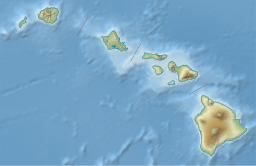Olomana (mountain) facts for kids
Quick facts for kids Olomana |
|
|---|---|
| Mount Olomana | |

View of the three peaks from Nu‘uanu Pali
|
|
| Highest point | |
| Elevation | 1,643 ft (501 m) |
| Naming | |
| English translation | "Divided Hill" |
| Language of name | Hawaiian |
| Geography | |
| Geology | |
| Volcanic arc/belt | Hawaii hotspot |
| Climbing | |
| Easiest route | Hike |
Olomana is a group of three mountain peaks located on the island of Oahu in Hawaii. These peaks are found on the windward (eastern) side of the island, near the towns of Kailua and Waimanalo.
While the name "Olomana" originally referred only to the first peak, most people today use it for all three. The second peak is called Paku'i, and the third, least pointed peak, is named Ahiki. Geologically, Olomana is what's left of an ancient volcano called the Koʻolau Volcano. It's an "erosional remnant," meaning it's a part of the volcano that has survived erosion over millions of years.
The Legend of Olomana
In the Hawaiian language, "Olomana" means "divided hill." This name comes from an old Hawaiian legend about a giant warrior.
According to the legend, Olomana was a powerful giant. He ruled the lands on the windward side of Oahu, from Kualoa all the way to Makapu'u. The king of Oahu, ʻAhuapau, sent a great warrior named Palila to challenge Olomana. In their battle, Palila defeated Olomana by cutting him in half.
The legend says that Olomana's upper body landed in the Pacific Ocean near Kāneʻohe Bay. His lower body remained where the Olomana peaks stand today. The legend of Makalei also tells us that the peak Ahiki was named after one of Chief Olomana's favorite konohiki (a type of headman or manager). The peak Pakuʻi was named after the person who looked after the Kaʻelepulu fishponds.
Hiking Olomana's Peaks
The trail that goes across the three Olomana peaks is about 2.5 miles long. Hikers gain about 1,643 feet in elevation from the start to the highest point. The path is quite rugged, meaning it's rough and uneven. Many parts of the trail are very steep and require ropes to help you climb safely.
Some very experienced hikers might try to climb without using ropes. However, this is extremely dangerous and is not recommended. It's always best to use the ropes provided for safety, especially on such a challenging trail.



